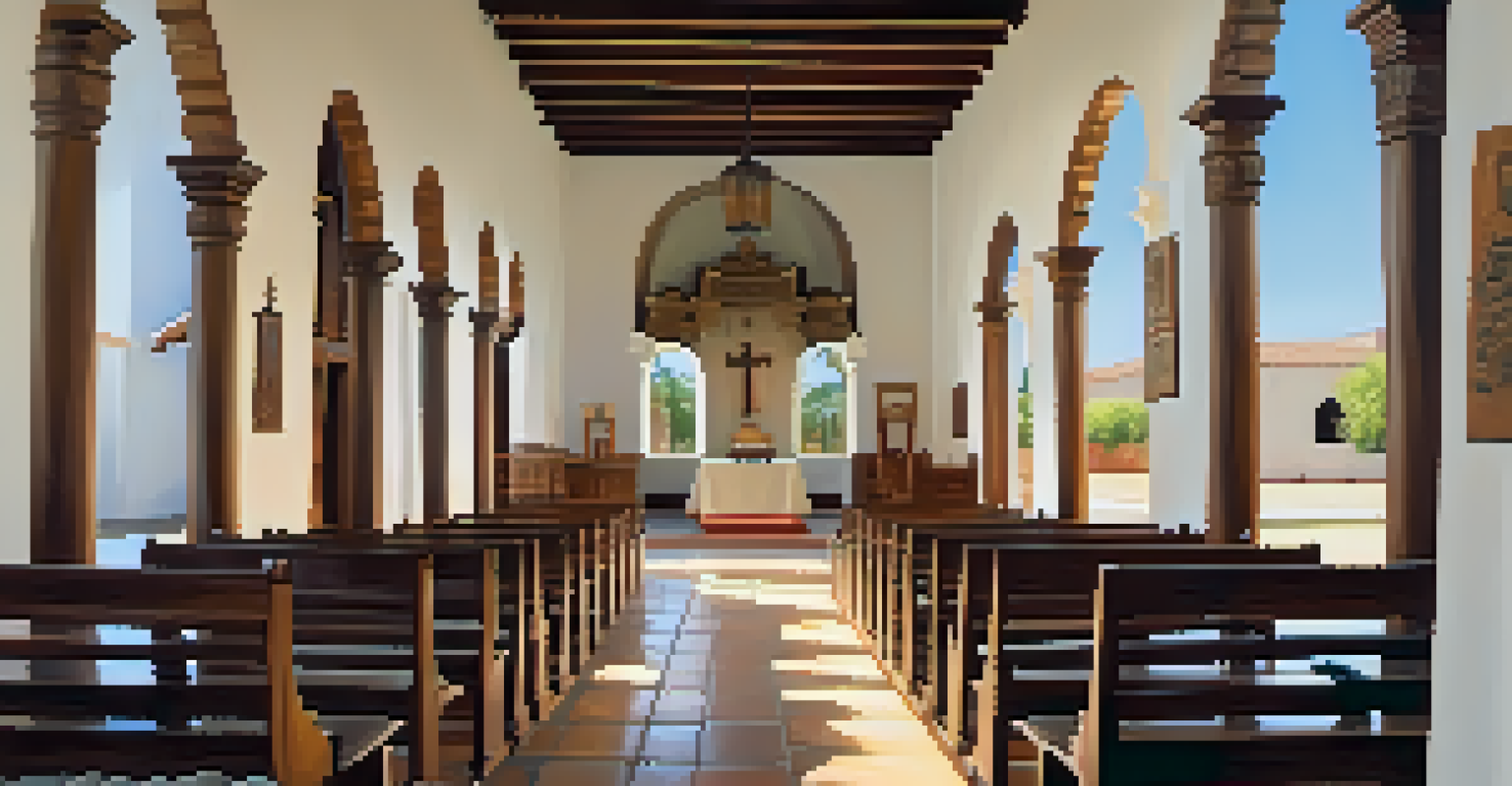The Significance of Mission San Diego de Alcalá in History

Introduction to Mission San Diego de Alcalá's Role
Mission San Diego de Alcalá, founded in 1769, holds a pivotal place in California's history. It was the first of the 21 California missions established by Spanish Franciscan missionaries. Located in what is now San Diego, this mission served as a spiritual and cultural hub for the indigenous Kumeyaay people.
History is not a burden on the memory but an illumination of the soul.
The establishment of the mission marked the beginning of European colonization in California, intertwining native cultures with Spanish customs. This blending of traditions created a unique cultural landscape that would shape the region for centuries. Understanding the mission's significance helps us appreciate the complex history of California.
As we delve deeper into its historical context, we see how Mission San Diego de Alcalá set the stage for future missions and the spread of Christianity across the state.
Cultural Exchange: The Meeting of Two Worlds
The arrival of Spanish missionaries at Mission San Diego de Alcalá initiated a significant cultural exchange between the Kumeyaay and European settlers. This interaction led to the introduction of new agricultural practices, including crops like wheat and cattle ranching. Such changes drastically transformed the indigenous way of life.

While this exchange brought some benefits, it also led to significant challenges, including the loss of land and cultural identity for the Kumeyaay. The mission's influence on local traditions and lifestyles illustrates both the positive and negative impacts of colonization. Exploring this duality helps us understand the complexities of cultural integration.
Cultural Exchange at the Mission
Mission San Diego de Alcalá facilitated a complex cultural exchange between the Kumeyaay and Spanish settlers, impacting both communities profoundly.
Ultimately, the mission became a site of both conflict and collaboration, highlighting the intricate dynamics of cultural exchange during this period.
Architectural Significance of the Mission
Architecturally, Mission San Diego de Alcalá showcases the Baroque style commonly associated with Spanish missions. Its adobe structures, adorned with beautiful wooden beams and a striking bell tower, reflect the artistic sensibilities of the time. This design not only served functional purposes but also aimed to inspire awe and reverence.
The past is never dead. It's not even past.
The mission's layout, with its central plaza and surrounding buildings, was a blueprint for subsequent missions throughout California. Each architectural element was thoughtfully designed to facilitate community life and spiritual practice. As we appreciate the mission's design, we also recognize its role in influencing the architectural heritage of the region.
Today, the mission stands as a historical landmark, preserving the architectural legacy of early California.
The Role of Mission San Diego de Alcalá in Education
Mission San Diego de Alcalá was not just a religious site but also a center for education. The missionaries provided instruction in various subjects, aiming to teach the Kumeyaay about European customs and agricultural practices. This educational role was crucial in fostering interaction between the two cultures.
However, the education provided often came at the expense of indigenous languages and traditions. As the mission sought to assimilate the Kumeyaay, many aspects of their rich cultural heritage were lost. The dual nature of this educational influence underscores the complexities of cultural exchange during the mission era.
Architectural Legacy of the Mission
The mission's Baroque architectural style and layout influenced the design of subsequent California missions, showcasing its historical significance.
Despite these challenges, the education imparted at the mission laid the groundwork for future generations, impacting the region's development.
The Mission's Impact on Local Economy
Mission San Diego de Alcalá played a vital role in shaping the local economy of the region. Through agriculture, the mission produced surplus goods that were traded with nearby communities and settlers. This economic activity contributed to the growth of San Diego as a burgeoning settlement.
With the introduction of livestock and new farming techniques, the mission helped establish an agricultural foundation that benefited both the missionaries and the indigenous population. However, this economic development often came at the cost of native land and resources, leading to conflicts over land use.
The mission's economic influence serves as a reminder of the intertwined fates of settlers and indigenous peoples, as they navigated the challenges of a changing world.
Preservation Efforts and Historical Recognition
Today, Mission San Diego de Alcalá stands as a testament to California's rich history, thanks to ongoing preservation efforts. The mission has been restored to reflect its original architecture and serves as a museum and cultural site. These efforts ensure that visitors can learn about its historical significance and the stories of those who lived there.
The mission is also recognized as a California Historical Landmark, highlighting its importance in American history. By acknowledging its past, we foster a deeper understanding of the cultural exchanges that shaped the region. Preservation efforts not only honor the mission's legacy but also educate future generations about its complexities.
Educational Role and Its Impact
While Mission San Diego de Alcalá aimed to educate the Kumeyaay in European customs, this often led to the loss of their indigenous languages and traditions.
As a historical site, Mission San Diego de Alcalá invites exploration and reflection on the intertwined histories of the Kumeyaay and the Spanish missionaries.
Conclusion: Lasting Legacy of Mission San Diego de Alcalá
The legacy of Mission San Diego de Alcalá endures in California's cultural and historical landscape. It serves as a reminder of the intricate relationships formed during colonization and the lasting impact on indigenous communities. Understanding this legacy helps us appreciate the diverse narratives that coexist in California's history.
As we reflect on the mission's role in education, economy, and cultural exchange, we recognize the importance of preserving these stories. The mission is not just a relic of the past; it is a living part of California's identity. Engaging with its history enriches our understanding of the state's diverse heritage.

In essence, Mission San Diego de Alcalá is a pivotal chapter in California's story, one that continues to inspire and inform our present.